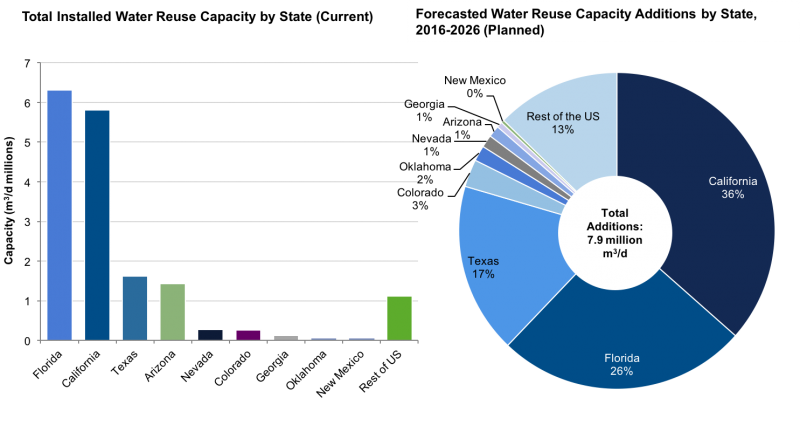BOSTON (Sept. 29, 2016)—Led by California and Florida, water reuse (the process of recycling wastewater) is taking off in states facing drought and scarcity. Municipal wastewater reuse capacity is expected to increase 58 percent from 2016 through 2026, according to new market forecasts from Bluefield Research. The estimate is based on a database of 607 currently planned reuse projects. CAPEX investment in reuse is expected to total $11 billion between 2016 and 2026.
“Water scarcity continues to be the primary driver for water reuse implementation—the scaling roster of projects demonstrated in our semi-annual review highlights wider adoption by utilities going forward,” Erin Bonney Casey, Senior Analyst for Bluefield Research, said in a statement.
California and Florida account for 36 percent and 26 percent, respectively, of currently planned reuse capacity additions. Florida has the most installed reuse capacity to date with 6.3 million cubic meters a day (m3/d) because of its long commitment to reuse to improve water quality and guarantee adequate supply for a growing population, according to Bluefield’s analysis.
“California is proving to be the greatest opportunity for reuse market growth, backed by US$4.3 billion of planned activity, an improving regulatory environment, and its well-documented drought,” Bonney Casey said. “So far projects have taken years to develop, but given the recent supply concerns, we anticipate a more streamlined process going forward, particularly for potable applications.”
Four states—Florida, California, Colorado and Texas—make up 581, or 95 percent, of planned reuse projects in the U.S, according to Bluefield. Colorado released its first statewide water plan in November 2015, outlining 51 planned reuse projects. Potable reuse projects—direct and indirect—are also gaining momentum with 2.6 million m3/d in capacity additions accounting for $2.9 billion investment in advanced treatment technology solutions.
“We expect the reuse pipeline to continue to grow as states continue to face drought conditions. Longer-term water planning cycles and regulation standardizing projects demonstrate greater support for the expansion of reuse systems and contribute to the growing pipeline of planned projects,” Bonney Casey said.
Bluefield’s forecast is founded on a proprietary dataset of more than 607 municipal reuse projects in various stages of development across the U.S. This database is updated regularly as projects are added to the pipeline and move through different phases of development. The above findings are from the organization’s latest update: U.S. Municipal Wastewater Reuse Update: Project Pipeline and Market Forecast, 2016-2026.



